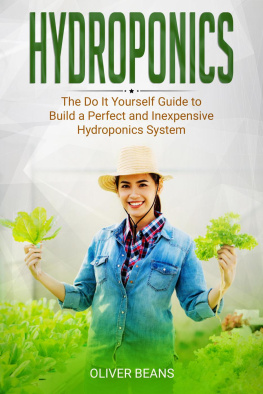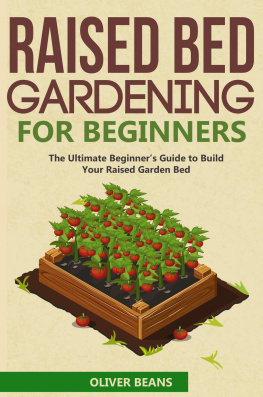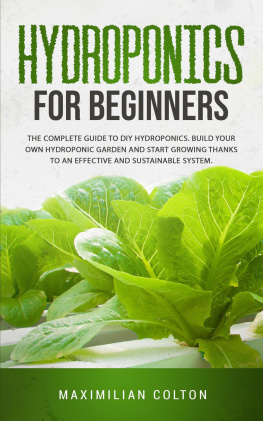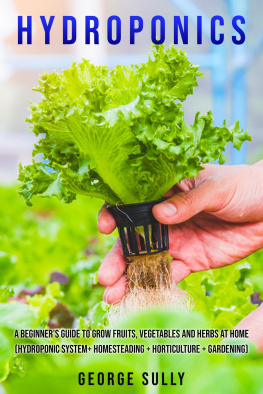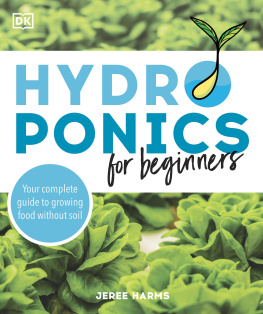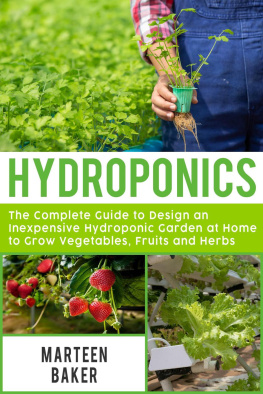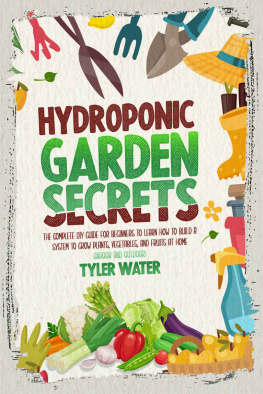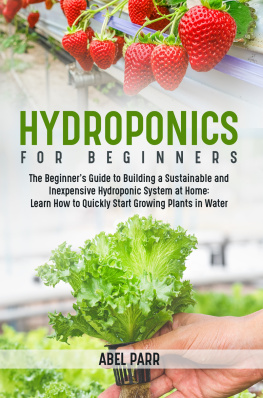
HYDROPONICS
The Do It Yourself Guide to Build a Perfect and Inexpensive Hydroponics System
Oliver Beans
COPYRIGHT 2020 by Oliver Beans
ALL RIGHTS RESERVED
T his document is geared towards providing exact and reliable information in regards to the topic and issue covered. The publication is sold with the idea that the publisher is not required to render accounting, officially permitted, or otherwise, qualified services. If advice is necessary, legal or professional, a practiced individual in the profession should be ordered. From a Declaration of Principles which was accepted and approved equally by a Committee of the American Bar Association and a Committee of Publishers and Associations. In no way is, it legal to reproduce, duplicate, or transmit any part of this document in either electronic means or in printed format. Recording of this publication is strictly prohibited and any storage of this document is not allowed unless with written permission from the publisher. All rights reserved. The information provided herein is stated to be truthful and consistent, in that any liability, in terms of inattention or otherwise, by any usage or abuse of any policies, processes, or directions contained within is the solitary and utter responsibility of the recipient reader. Under no circumstances will any legal responsibility or blame be held against the publisher for any reparation, damages, or monetary loss due to the information herein, either directly or indirectly. Respective authors own all copyrights not held by the publisher. The information herein is offered for informational purposes solely, and is universal as so. The presentation of the information is without contract or any type of guarantee assurance. The trademarks that are used are without any consent and the publication of the trademark is without permission or backing by the trademark owner. All trademarks and brands within this book are for clarifying purposes only and are the owned by the owners themselves, not affiliated with this document
Table of Contents
S
omehow, whenever we hear about having a garden or planting crops and vegetables, we sort of unconsciously think of heaps of loamy soil, with dirt and compost manure somewhere, then the rows of plant standing in our backyards.
But actually, gardening and agriculture are no longer limited to this!
You need to realize that a lot of the veggies and fruits we now consume are not grown on land! Especially around the temperate regions where it is snowy, and the area is frigid, preventing crops from growing.
Man, to keep certain foods and crops available all year round, invented a means to plant crops using water alone under controlled temperatures. This method of planting crops on the water is called Hydroculture. As the year goes by, man is adapting and trying to make the best out of his environment.
We no longer need soil to plant.
A system of planting, in which terrestrial plants are grown on water-based nutrient solutions are already commonplace.
I tell you, is the future of agriculture.
Hydroculture is a method of planting crops on mineral solutions where distilled water is the solvent. But in this book, we want to focus on a branch of hydroculture called: hydroponics. Hydroponics is a method of growing terrestrial crops without soil.

Fig 1- Hydroponic System
O f course, just like in the traditional gardens, plants are made to stand in rows. The difference now is, instead of growing on soil, the roots of these usually terrestrial plants are in the water.
Do not get so shocked: the soil is not the nutrient plants need!
Of course, you have the idea that there are different types of soil, and these different types of soil allow the growth of different kinds of crops.
Why?
This is because different kinds of soil have different types of nutrients embedded in them, so because of the nature of nutrient predominant or lacking in the various soil types, they only facilitate the growth of varying kinds of plants.
What am I trying to say? The soil is not the nutrient! The ground is just a support for the root of plants.
The nutrient is contained in the soil, so if we can have a way of extracting these nutrients from the ground, we can have the plants grow wherever the nutrients are!
Therefore, the actual nutrients come from decomposed materials, animal wastes, water, and other chemicals in the soil. So, get these things out and put them on water: you are already making a hydroponic system to grow plants. Now in a situation where the root of the plants cannot be supported by the water alone, which is the actual job of soil support, physical support can be created for the plant using some inert materials.

F ig.2 - NFT hydroponic system
This is the ABC of hydroponic gardening.
Crops grown hydroponically, according to studies, grow faster and healthier. They are better than crops grown on soil. This is because they don't have to go through a lot of disadvantages that the soil may present: for example, the attack from organisms and pests that live in the ground. And of course, the plants in hydroponic systems do not have to hustle for nutrients and water, because basically, this is what they are planted in, in hydroponic systems (water-based mineral nutrient solutions).
Do not get scared, hydroponic gardening is not as complicated; on the contrary, it is elementary!
And this is what this book is about: to enlighten you and get you started on having your own hydroponic garden.
Did you know that there are now kits, tools, how-to books (like this one), self-help systems, and, of course, automated systems for hydroponic gardening to help home gardeners improve their efficiency and effectiveness?
Truthfully, hydroponics, in my opinion (which in time I will convince and show you) is easier than planting crops on the soil. This is true on many counts.
The basic needs of plants for their growth are sunlight, nutrients, water, air, and the right temperature, and hydroponics breaks the whole thing down so that the only things supplied to the crops are these things which they need, without stress and available all the time.
Lands on which we have good soil for planting are increasingly becoming scarce for a lot of reasons such as industrialization, developments, and other kinds of buildings, so it becomes imperative for a man to follow his instincts for survival, which is adaptation to the changing times and challenges. Hydroponics is one of such solutions to the challenges of land, agriculture, and food production. And it has, over time, proven to be a better alternative. Some of the advantages of hydroponics over the traditional method of gardening include:
Next page
